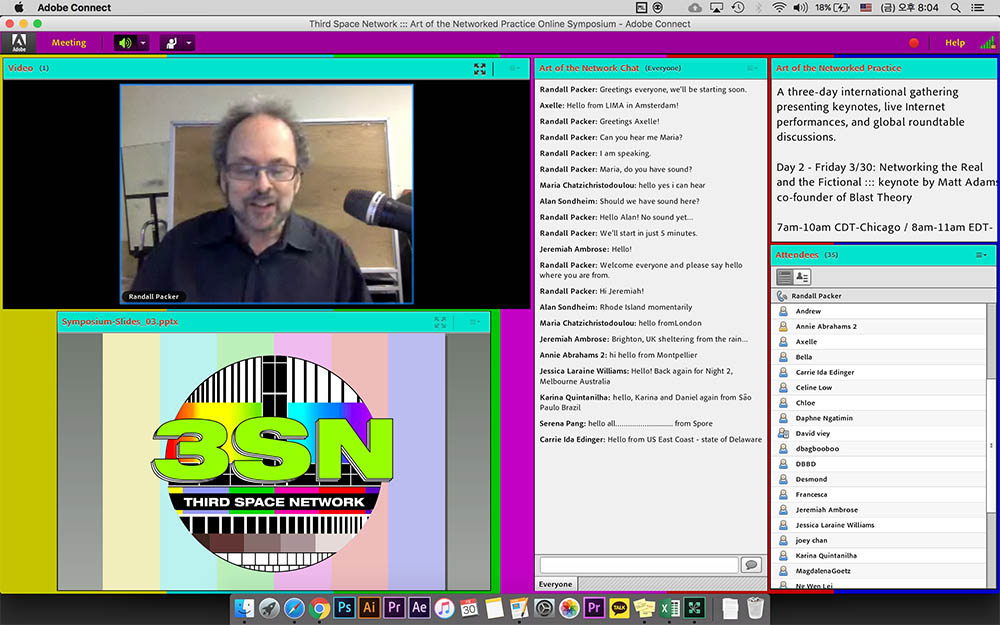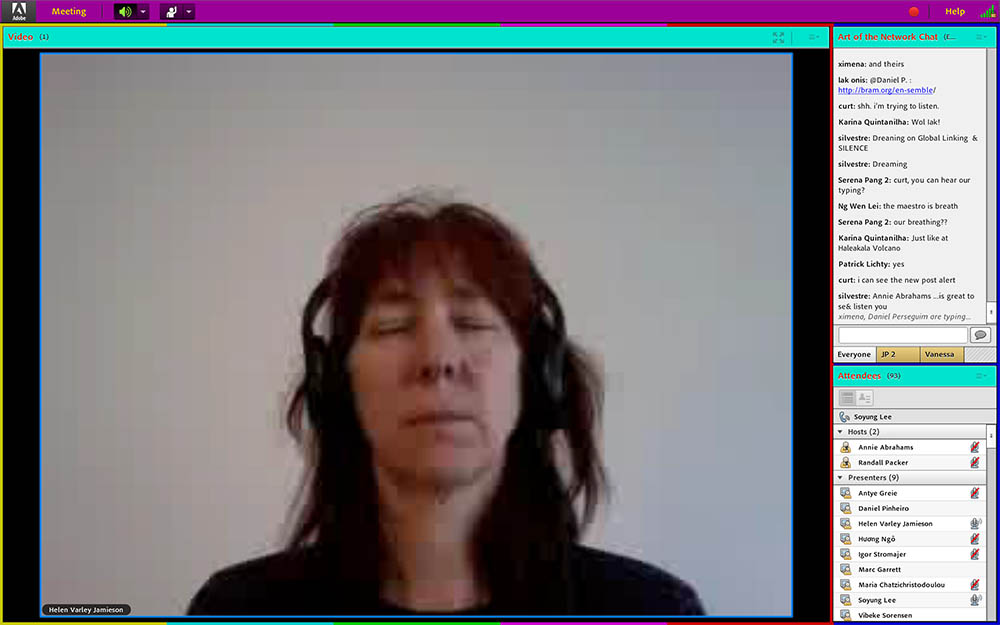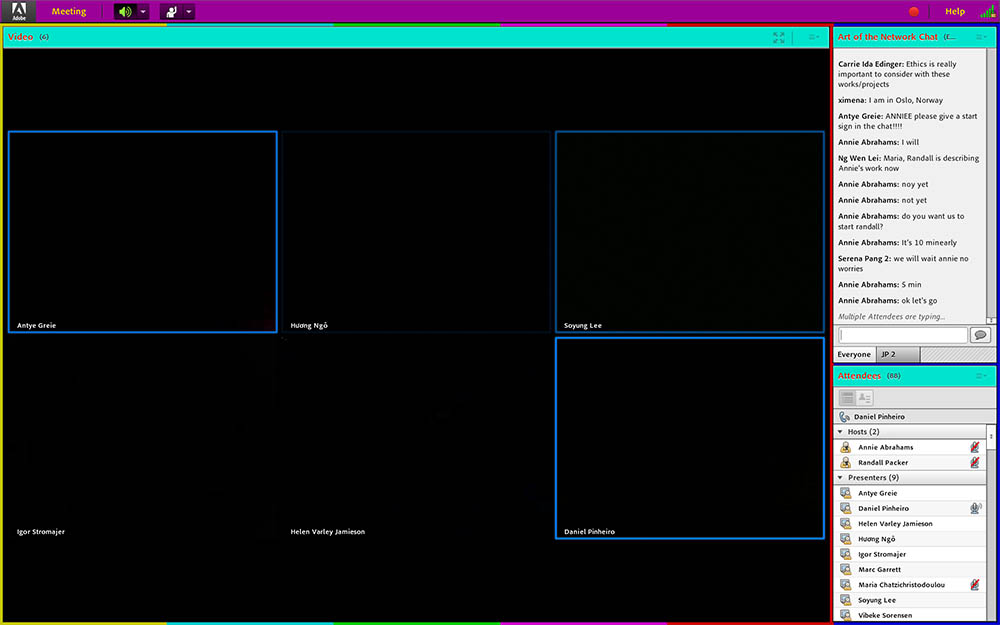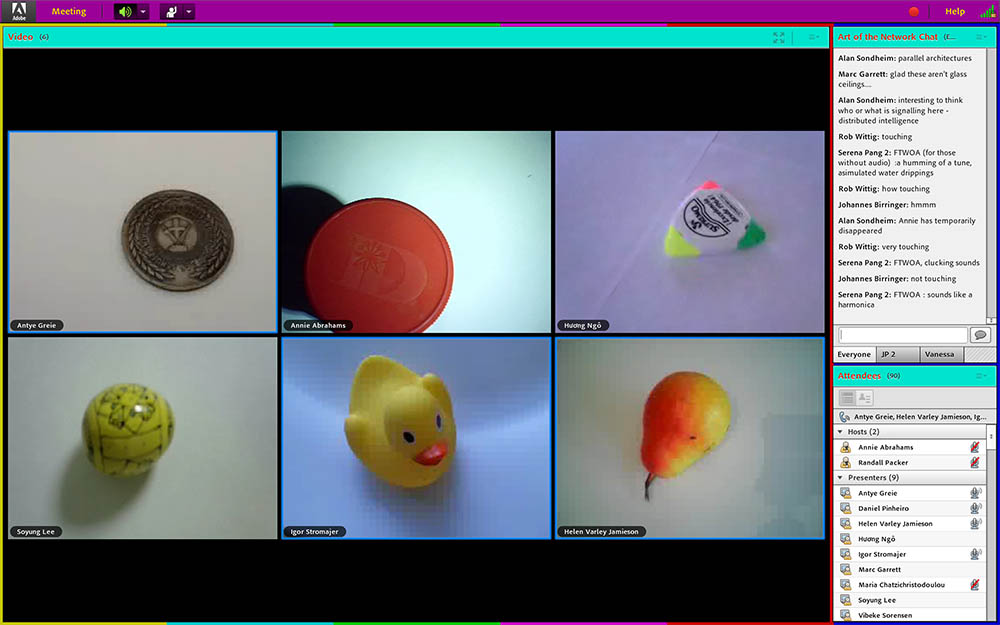Interface on the screen
The adobe connect interface was made of video, keynote, Chat, Information and Attendees list windows. The interface was changed from time to time by presenters. Presenters could expand specific window or turn on-off their camera and voice.

Selecting the way to present or absent
It was pretty amazing experience that I participated in online symposium which almost 80 people attended. It was totally different from offline symposium which would be held in auditorium. It changed our ways of presence. It means that presenters could choose their ways of presence and communication. During the Global Roundtable Discussion after performance, there was a little bit of disconnection, and Annie said “I’m going sound.” It was not for all attendees but she could choose media to present herself among visual, sound, text. Being online means that I could be there through media which is I want to present myself. We became a fragment of media on the screen. During the performance, we as fragments of media gathered together and created the online performance.
Changing relationship between artists and audiences
It was really interesting for me that there was a repositioning of power during symposium between artists and audiences. Traditionally, artist creates an art work and meaning of it. Audience see it and struggles to understand the meaning that artists hide behind visual image. Artist has the power of information and knowledge about his/her artwork. Audience should think, ask and find or even study to get information and knowledge. In other words, there is a relationship of power between artist and audience.
While Annie Abrahams and her collaborators showed the performance, online attendees were doing really different reaction on the chat window compared to traditional audiences who are in front of the performance. They tried to explain the sound to other attendees who might not be able to listen the sound and talked with others about how they looked and understood the performance. Also attendees were trying to participate by persuading and understanding others on the chat window. They participated actively in the context of the performance and that was the moment where the boundary between artists and audiences was blurred. I felt like it was the performance which truly shared and mediated by network. It was where the artists are disappeared. Not just audiences understand and enjoy the performance which artists made, but they really create and collaborate with artists and other people to form and reform the meanings of the work. By doing so, the attendees could create the meaning and context of the performance together with the performers, even though they could not engage in the performance physically.

In my opinion, this participatory interface of Adobe Connect showed us new possibility of relationships and communication between artists and audiences. I thought during the performance, all attendees in Adobe Connect were engaged deeply in the performance, not just as participants, but as viewer, maker, and spectator. Attendees reconstructed power relationship. At some point in the symposium, all the presenters and attendees have equal power to the performance or even symposium.
During the symposium, especially on the first day, I felt that there was the changes of relationships between artists and audiences. But when the artists got their microphone on, the relationship was changed back to traditional relationship. Audiences asked questions and artists answered. There was no gap where audiences made their own stories or contexts of the work. At the same time, the sense of imaginary community was broken. During the performance, there was no relationship of power between window so online participants could be all equal participants. After performance, the power was distributed and it created hierarchy. The window that showed the images and sounds of artists became so-to-speak the main part on the screen. The chat window became second part which was sometimes important but sometimes not, like a whisper.
Social Broadcasting: Making a temporary imaginary community sharing interface
Through online symposium, people formed a temporary group which people shared their opinion and thinking at a distance.
On my first research post of this semester, I wrote about the death of the author coined by Rolland Barthe. At that time, I could only imagine ‘prosumer’ as the future of the art. The three days of online symposium made me realize other possibility. I think it’s time to imagine new words to change the traditional notion of artists and audiences. It could be attendees.
After blurring the boundaries between artists and audiences, and artworks and viewers, what will remain? Maybe we don’t need the words “artist”, and “audience” because there’s no border anymore. We can call just “user” or “maker” of the system. Let’s imagine the future of the art, could it be “prosumer“?
–imagine the art of the future, multimedia, Jan 23 2018
I think people who attended the symposium made a temporary virtual community by sharing interface together. Some of them gave their images and sounds, some of them wrote texts on the screen, and some of them put their presence on the interface.
If I could say that ‘real’ is an empty image that could be replaced, for me, the Art of Networked Practice Online Symposium was ‘temporary reality’ at that time. In physical reality, I was in my private room and saw my laptop screen. But some virtual clues made me concentrate on and engage in the online symposium. There were the simultaneous fragmented media from other attendees such as videos, keynotes, comments, recommendations, presence. And it created temporary virtual reality on the screen.
In my opinion, ‘real’ is an empty image. If some clues satisfy the sense of real to some extent, people could make a real in their own way. In short, ‘real’ is replaceable. Therefore it is an empty image that we could fill it with temporary reality.
–Telematic Dreaming, Paul Sermon, 1992, March 13 2018
On the third day of symposium, Randall Packer who directed this symposium said “I’d like to say Good night, Good afternoon, now it’s Good morning for some of you maybe in the west coast in the US.” Attendees who made this community were dispersed after the symposium. Could I say that we were a temporary imaginary community sharing a kind of online state and interface to create a possible reality in online adobe connect?



Seung, I am very excited about your discussion of the temporary community that was formed during the Symposium. In fact, Gene Youngblood the media historian would call this an “autonomous reality community,” and I think you touched on this idea very closely. In a sense, the distributed audience from around the world formed a community that functioned as a moment of a constructed reality, a constructed space, where dialogue, actions, performance could freely be exchanged. I found your description of the online viewers very interesting also, as a parallel performance, commenting, critiquing, responding, and as you pointed out interpreting what was happening at any given moment.
This could never happen in traditional theater, where such audience discourse would be a distraction rather than be complementary. In the third space, the silent chat becomes an accompaniment, which in turn can affect the performance since the performers can see and pay attention, if they want, to the audience reactions.
And I thought it was very interesting, how in the discussion, there was a return to more conventional hierarchies. It is true, that with the performance, there is a moment of a new reality, a flattening of hierarchy, a community space where everyone can participate.
Excellent work!